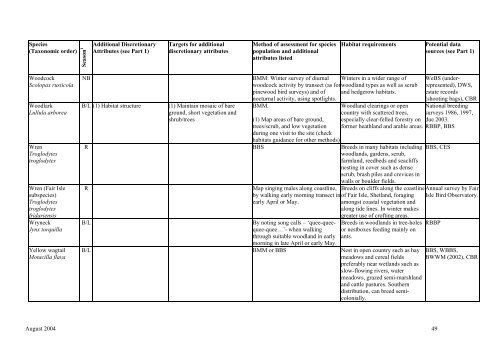Common Standards Monitoring guidance for birds - JNCC
Common Standards Monitoring guidance for birds - JNCC
Common Standards Monitoring guidance for birds - JNCC
Create successful ePaper yourself
Turn your PDF publications into a flip-book with our unique Google optimized e-Paper software.
Species<br />
(Taxonomic order)<br />
Season 1<br />
Additional Discretionary<br />
Attributes (see Part 1)<br />
Targets <strong>for</strong> additional<br />
discretionary attributes<br />
Method of assessment <strong>for</strong> species<br />
population and additional<br />
attributes listed<br />
Habitat requirements<br />
Potential data<br />
sources (see Part 1)<br />
Woodcock<br />
Scolopax rusticola<br />
Woodlark<br />
Lullula arborea<br />
Wren<br />
Troglodytes<br />
troglodytes<br />
Wren (Fair Isle<br />
subspecies)<br />
Troglodytes<br />
troglodytes<br />
fridariensis<br />
Wryneck<br />
Jynx torquilla<br />
Yellow wagtail<br />
Motacilla flava<br />
NB BMM: Winter survey of diurnal Winters in a wider range of<br />
woodcock activity by transect (as <strong>for</strong> woodland types as well as scrub<br />
pinewood bird surveys) and of and hedgerow habitats.<br />
nocturnal activity, using spotlights.<br />
B/L (1) Habitat structure (1) Maintain mosaic of bare BMM.<br />
ground, short vegetation and<br />
shrub/trees<br />
(1) Map areas of bare ground,<br />
trees/scrub, and low vegetation<br />
during one visit to the site (check<br />
habitats <strong>guidance</strong> <strong>for</strong> other methods)<br />
Woodland clearings or open<br />
country with scattered trees,<br />
especially clear-felled <strong>for</strong>estry on<br />
<strong>for</strong>mer heathland and arable areas.<br />
R BBS Breeds in many habitats including<br />
woodlands, gardens, scrub,<br />
farmland, reedbeds and seacliffs<br />
nesting in cover such as dense<br />
scrub, brash piles and crevices in<br />
walls or boulder fields.<br />
R Map singing males along coastline,<br />
by walking early morning transect in<br />
early April or May.<br />
B/L By noting song calls – ‘quee-queequee-quee…’-<br />
when walking<br />
through suitable woodland in early<br />
morning in late April or early May.<br />
WeBS (underrepresented),<br />
DWS,<br />
estate records<br />
(shooting bags), CBR<br />
National breeding<br />
surveys 1986, 1997,<br />
due 2003.<br />
RBBP, BBS<br />
BBS, CES<br />
Breeds on cliffs along the coastline Annual survey by Fair<br />
of Fair Isle, Shetland, <strong>for</strong>aging Isle Bird Observatory.<br />
amongst coastal vegetation and<br />
along tide lines. In winter makes<br />
greater use of crofting areas.<br />
Breeds in woodlands in tree-holes<br />
or nestboxes feeding mainly on<br />
ants.<br />
B/L BMM or BBS Nest in open country such as hay<br />
meadows and cereal fields<br />
preferably near wetlands such as<br />
slow-flowing rivers, water<br />
meadows, grazed semi-marshland<br />
and cattle pastures. Southern<br />
distribution, can breed semicolonially.<br />
RBBP<br />
BBS, WBBS,<br />
BWWM (2002), CBR<br />
August 2004 49
















